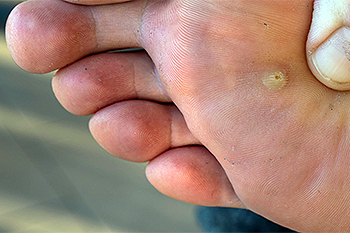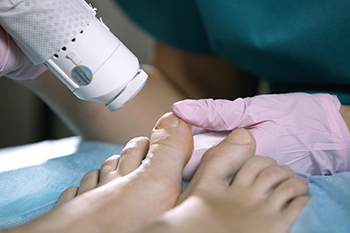Items filtered by date: February 2022
Heel Spurs: The Body’s Response to Stress on Ligaments and Tendons
A heel spur is a pointy accumulation of calcium deposits that build up over time on the heel bone. They are the body’s response to repetitive strain or localized inflammation where soft tissues meet the bone. Heel spurs can develop at various locations on the heel bone. When the Achilles tendon becomes inflamed, a heel spur can sometimes develop at the back of the heel (where the tendon attaches to the bone). When the long tissue that connects the toes with the heel (plantar fascia) becomes damaged and inflamed, heel spurs can sometimes form on the heel under the arch. Obesity, gait abnormalities, flat feet or high arches, age, improperly fitted shoes, and other factors that stress the feet can also contribute to the formation of a heel spur. Some heel spurs can cause pain and tenderness, while others are asymptomatic, and only become discovered on an X-ray taken to diagnose another condition. A podiatrist can treat a heel spur through a variety of conservative treatments including icing and resting, physical therapy, stretching, oral or injectable anti-inflammatory medications, and custom orthotic devices.
Heel spurs can be incredibly painful and sometimes may make you unable to participate in physical activities. To get medical care for your heel spurs, contact David Jenson, DPM, FAENS from Jenson Foot and Ankle Specialist. Our doctor will do everything possible to treat your condition.
Heels Spurs
Heel spurs are formed by calcium deposits on the back of the foot where the heel is. This can also be caused by small fragments of bone breaking off one section of the foot, attaching onto the back of the foot. Heel spurs can also be bone growth on the back of the foot and may grow in the direction of the arch of the foot.
Older individuals usually suffer from heel spurs and pain sometimes intensifies with age. One of the main condition's spurs are related to is plantar fasciitis.
Pain
The pain associated with spurs is often because of weight placed on the feet. When someone is walking, their entire weight is concentrated on the feet. Bone spurs then have the tendency to affect other bones and tissues around the foot. As the pain continues, the feet will become tender and sensitive over time.
Treatments
There are many ways to treat heel spurs. If one is suffering from heel spurs in conjunction with pain, there are several methods for healing. Medication, surgery, and herbal care are some options.
If you have any questions feel free to contact our office located in The Woodlands, TX . We offer the latest in diagnostic and treatment technology to meet your needs.
Read more about How to Treat Heel SpursWhy Laser Treatment for Fungal Nails Can Be Effective
Fungal infections of the toenail (onychomycosis) can cause nails to thicken, turn yellow, and possibly separate from the nail bed. Onychomycosis can be very stubborn and difficult to treat. This is because the nail grows so slowly, and fungus gets in between the multiple layers making up the nail, under the nail, or even in the nail matrix. Laser treatment for fungal nails is believed to be an effective and safe treatment for the eradication of onychomycosis. This is because the laser can penetrate the nail and be precisely targeted to attack the fungus without damaging surrounding skin or tissue. Laser treatment for fungal nails can take as little as one treatment and prevent the infection from spreading or returning. If you have developed a fungal toenail infection, ask your podiatrist if laser treatment is right for you.
Laser treatment can be an effective way to get rid of toenail fungus. If you have any questions about laser treatment, consult with David Jenson, DPM, FAENS from Jenson Foot and Ankle Specialist. Our doctor will assess your condition and provide you with quality treatment for fungal nails.
What Are Toenail Fungal Infections?
Onychomycosis, or fungal infection of the nail, is a relatively common and non-serious condition. Around 10 percent of U.S. citizens are afflicted with fungal nails. Common forms of fungus that infect the nail include dermatophytes, yeasts, and molds.
Symptoms of Toenail Fungal Infections Include:
- Nail thickening
- Brittleness of the nail
- Discoloration of the nail
Diagnosis for Fungal Nails
Fungal infections are diagnosed by fungal culture and microscopy. This will rule out any other conditions such as nail trauma, psoriasis, lichen planus, and onychogryphosis.
What Is Laser Treatment?
Laser treatment is a non-invasive, safe, quick, and painless procedure that uses the heat from a laser to kill fungus in the nail. Each infected nail is targeted with a laser for several minutes. The treatment is usually utilized several different times over a select period. During this time, a podiatrist will keep an eye on the infection.
If you have any questions, please feel free to contact our office located in The Woodlands, TX . We offer the newest diagnostic and treatment technologies for all your foot care needs.
Read more about Laser Treatment for Fungal NailsHow Plantar Warts Spread
 Plantar warts, which may also be referred to as verrucae, grow on the soles of the feet or around the toes because of the Human Papilloma Virus (or HPV). This is a highly contagious virus that thrives in warm and moist environments, such as pools, locker rooms and communal showers. HPV is both contagious through person to person contact and simply by walking through the same floor area as someone who has a wart. When plantar warts form, they will appear as a small growth with a tiny black dot in the center (usually dried blood), and they can be very painful. Plantar warts can grow as large as a centimeter in diameter, or can even form into a cluster of multiple warts. While plantar warts may be very painful, especially when pressure is applied, they are harmless. However, patients who are have a painful plantar wart, or recurring plantar warts, would be wise to schedule a visit with a podiatrist.
Plantar warts, which may also be referred to as verrucae, grow on the soles of the feet or around the toes because of the Human Papilloma Virus (or HPV). This is a highly contagious virus that thrives in warm and moist environments, such as pools, locker rooms and communal showers. HPV is both contagious through person to person contact and simply by walking through the same floor area as someone who has a wart. When plantar warts form, they will appear as a small growth with a tiny black dot in the center (usually dried blood), and they can be very painful. Plantar warts can grow as large as a centimeter in diameter, or can even form into a cluster of multiple warts. While plantar warts may be very painful, especially when pressure is applied, they are harmless. However, patients who are have a painful plantar wart, or recurring plantar warts, would be wise to schedule a visit with a podiatrist.
Plantar warts can be very uncomfortable. If you need your feet checked, contact David Jenson, DPM, FAENS from Jenson Foot and Ankle Specialist. Our doctor will assist you with all of your foot and ankle needs.
About Plantar Warts
Plantar warts are the result of HPV, or human papillomavirus, getting into open wounds on the feet. They are mostly found on the heels or balls of the feet.
While plantar warts are generally harmless, those experiencing excessive pain or those suffering from diabetes or a compromised immune system require immediate medical care. Plantar warts are easily diagnosed, usually through scraping off a bit of rough skin or by getting a biopsy.
Symptoms
- Lesions on the bottom of your feet, usually rough and grainy
- Hard or thick callused spots
- Wart seeds, which are small clotted blood vessels that look like little black spots
- Pain, discomfort, or tenderness of your feet when walking or standing
Treatment
- Freezing
- Electric tool removal
- Laser Treatment
- Topical Creams (prescription only)
- Over-the-counter medications
To help prevent developing plantar warts, avoid walking barefoot over abrasive surfaces that can cause cuts or wounds for HPV to get into. Avoiding direct contact with other warts, as well as not picking or rubbing existing warts, can help prevent the further spread of plantar warts. However, if you think you have developed plantar warts, speak to your podiatrist. He or she can diagnose the warts on your feet and recommend the appropriate treatment options.
If you have any questions please feel free to contact our office located in The Woodlands, TX . We offer the newest diagnostic and treatment technologies for all your foot and ankle needs.
Read more about Plantar WartsHow Blisters Serve a Purpose
When skin becomes damaged due to friction, a small bubble of fluid can form in the epidermis in order to protect the layers of skin beneath it which allow the skin to heal. Blisters are typically filled with a clear serum, but in some cases where there is excess pressure or friction, the sac may fill with blood. If the blister becomes infected, pus may collect in the blister. An infected blister may also become red, swollen, or painful. Most blisters will heal on their own if they are left alone, allowing the new skin to grow underneath it. Blisters should not be popped, as they provide a protective barrier that keeps bacteria away from the damaged skin to ward off further damage and infection. Wearing shoes that fit properly and are flexible can go a long way in avoiding blisters from forming. Socks that are clean and keep moisture away from the skin are also beneficial, as moist skin can blister more easily. If a blister becomes infected, it is suggested that you contact a podiatrist who can help cure the infection, help your skin to heal, and offer preventive methods to avoid the formation of blisters.
Blisters are prone to making everyday activities extremely uncomfortable. If your feet are hurting, contact David Jenson, DPM, FAENS of Jenson Foot and Ankle Specialist. Our doctor can provide the care you need to keep you pain-free and on your feet.
Foot Blisters
Foot blisters develop as a result of constantly wearing tight or ill-fitting footwear. This happens due to the constant rubbing from the shoe, which can often lead to pain.
What Are Foot Blisters?
A foot blister is a small fluid-filled pocket that forms on the upper-most layer of the skin. Blisters are filled with clear fluid and can lead to blood drainage or pus if the area becomes infected.
How Do Blisters Form?
Blisters on the feet are often the result of constant friction of skin and material, usually by shoe rubbing. Walking in sandals, boots, or shoes that don’t fit properly for long periods of time can result in a blister. Having consistent foot moisture and humidity can easily lead to blister formation.
Prevention & Treatment
It is important to properly care for the affected area in order to prevent infection and ease the pain. Do not lance the blister and use a Band-Aid to provide pain relief. Also, be sure to keep your feet dry and wear proper fitting shoes. If you see blood or pus in a blister, seek assistance from a podiatrist.
If you have any questions, please feel free to contact our office located in The Woodlands, TX . We offer the newest diagnostic and treatment technologies for all your foot care needs.
Read more about Blisters on the Feet


